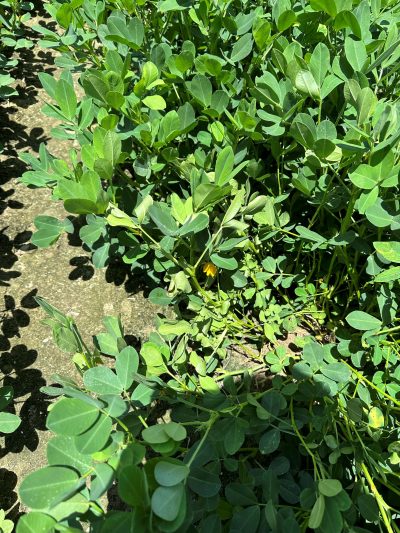In scouting peanut fields over the last week, things mostly look good! Fields have recovered from an excessively hot, dry June, plants have lapped, or nearly lapped the row middles, and weeds are mostly cleaned up. However, of immediate concern is the emergence of white mold in fields – just a quick walk in several area fields last week revealed isolated plants in each field crashing from the disease. These isolated incidents won’t stay isolated long however, if growers aren’t proactive in halting the spread.
White mold, the disease caused by the fungal pathogen Sclerotium rolfsii, typically heats up around this time each year in conjunction with hot days, warm humid nights, and the arrival of periodic, scattered rainfall. The first visible symptoms of disease are plants, or even individual stems of plants, that appear wilted or “flagged”. A closer look of these flagging plants usually reveals white fungal growth wrapping the base of the stem near the soil line, essentially girdling the upper portion of the stem (hence the wilting), and often small round, BB shaped sclerotia. As the disease progresses, plants begin to crash and fungal growth can be seen spreading within rows to other plants, leading to collapses of entire sections of row – obviously not a good situation.
The hot, humid climatic conditions at this time of the year, coinciding with the dense, moisture-holding peanut plant canopy allows these isolated pops of white mold to spread like wildfire throughout the field if unchecked and can negatively impact yield. So, what should growers be doing right now to ensure these unavoidable white mold flare ups don’t coalesce into a field-wide epidemic?
- As always, scout fields or make sure your consultants are scouting regularly and inspect the crown of visibly wilted plants for confirmation of white mold.
– - If white mold is found, fungicides with significant white mold activity should be applied (these include Convoy, Excalia, Elatus, Umbra, Fontelis, Tebuconazole, and others). These applications should either be delivered with enough water to penetrate the plant canopy down to the crown where the disease is active, delivered at night, or be watered in through irrigation or rainfall within 24 hours. In high-risk fields and/or in high-risk weather situations (hot and humid), scheduled fungicide applications may be a safer bet than waiting until disease is present.

A closer look under the canopy reveals white fungal growth and small, BB shaped structures. Photo courtesy of Daniel Leonard.
If you or a grower you work with run into severe white mold problems this season, despite your management efforts, there are a couple of practices that can be implemented next season to reduce overall field risk to white mold. The first, but most uncomfortable option considering current prices for other commodities, is to not plant peanut more than once every three years. Back-to-back or even continuous peanut rotations invites heavy disease pressure and longer rotation out of peanut (with cotton, corn or another nonhost crop) can help to break disease cycles. The next is to plant a variety with a lower white mold risk profile on the PeanutRx (2024 Peanut Rx Interactive Analysis Tool). To date the variety with the lowest white mold risk is Georgia-12Y with a risk index of 10, but it’s important to note that no currently available peanut variety is considered highly resistant to white mold.
In summary, conditions are ripe for a white mold outbreak in Panhandle fields. Growers should be vigilant scouting for the disease and, if found, shouldn’t hesitate to apply a fungicide with significant white mold activity. Implementing these management practices will help ensure a healthy second half of the peanut growing season and a profitable peanut harvest. For information on white mold management, be sure to contact your local UF/IFAS County Extension office.
- Stay Ahead of Peanut Fungal Pathogens This Summer - August 8, 2025
- Panhandle Cotton Acres Are Down in 2025– Here’s the Reason - July 11, 2025
- It Snowed, But Has This Been a Historically Cold Winter? What the Data Says. - January 31, 2025

